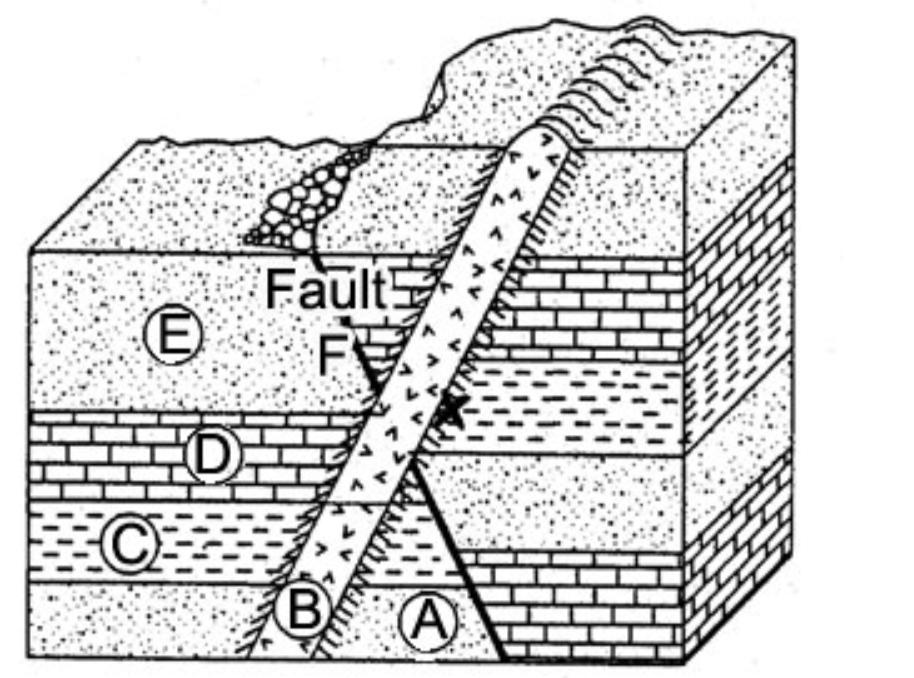Original Horizontality and Cross-Cutting Relationships
Merry Wilson and Charlene Estrada
The Principle of Original Horizontality was proposed by the Danish geological pioneer Nicholas Steno (1638–1686). This principle states that layers of sediment are originally deposited horizontally under the action of gravity. The principle is important to the analysis of folded and tilted strata. From these observations is derived the conclusion that the Earth has not been static and that great forces have been at work over long periods of time, further leading to the conclusions of the science of plate tectonics; that movement and collisions of large plates of the Earth’s crust is the cause of folded strata.

Figure Above: What is original horizontality? When encountering tilted strata, un-tilt them by imagining what they would be like if they were rotated so that they were all horizontal and parallel to one another.
As one of Steno’s Laws, the Principle of Original Horizontality served well in the early days of geological science. However, it is now known that not all sedimentary layers are deposited purely horizontally. For instance, coarser-grained sediments such as sand may be deposited at angles of up to 15 degrees. The internal friction between grains prevents them from slumping to a lower angle without additional reworking or effort. This is known as the angle of repose, and a prime example is the surface of sand dunes. Similarly, sediments may drape over a pre-existing inclined surface: these sediments are usually deposited conformably to the pre-existing surface.
Also, sedimentary beds may pinch out along strike, implying that slight angles existed during their deposition. Thus the Principle of Original Horizontality is widely, but not universally, applicable in the study of sedimentology, stratigraphy, and structural geology. Sedimentary rocks are originally laid down in horizontal layers. If the sedimentary rocks are tilted, the tilting event happens after the layers originally formed. To determine which layer is the youngest, un-tilt the layers back to horizontal in the shortest direction of rotation.

Image Above: Which layers are youngest and which layers are oldest? See the text below for a description and an answer.
When looking at the tilted layers in the lower right image you should notice that the rocks are tilted to the right. This means the layers on the right side of the image are younger and get progressively older as you move to the left.
Principle of Crosscutting Relationships
Originally developed by James Hutton in Theory of the Earth (1795) and embellished by Charles Lyell in Principles of Geology (1830), the principle of cross-cutting relationships states that the geologic feature which cuts another is the younger of the two features.
There are several basic types of cross-cutting relationships:
- Structural relationships may be faults or fractures cutting through older rock.
- Intrusional relationships occur when an igneous pluton or dike is intruded into pre-existing rocks.
- Stratigraphic relationships may be an erosional surface (or unconformity) cuts across older rock layers, geological structures, or other geological features.
- Sedimentological relationships occur where currents have eroded or scoured older sediment in a local area to produce, for example, a channel filled with sand.
- Paleontological relationships occur where the animal activity or plant growth produces truncation. This happens, for example, when animal burrows penetrate pre-existing sedimentary deposits.
- Geomorphological relationships may occur where a surficial feature, such as a river flowing through a gap in a rock ridge. In a similar example, an impact crater excavates into a subsurface layer of rock.
Cross-cutting relationships may be compound in nature. For example, if an unconformity truncated a fault, and that unconformity was cut by a dike. Based upon such compound cross-cutting relationships, it can be seen that the fault is older than the unconformity, which in turn is older than the dike. Using such rationale, the sequence of geological events can be better understood. When a rock layer or fault cuts across another rock layer or fault, the thing doing the cutting must be younger than the object it cuts.
Inclusions: When pieces of rock or material are included within a rock layer, the included pieces must be older than the rock they are included in.

Figure Above: When features are cut across layers of rock, these features must be younger than the rock they are cutting across. Such features include volcanic dikes, sills, faults and fractures.

Figure Above: Layer T is at the bottom, and above it is layer J. Above layer J is layer O. Above layer O is layer R. Above layer R is layer D. Layers T through D are tilted. A volcanic dike, W, cuts across layers T through D. Above layer D is layer Y. Above layer Y is layer A. Cutting across layers T through A is fault F. Above layer A is layer B. Above layer B is layer X.


